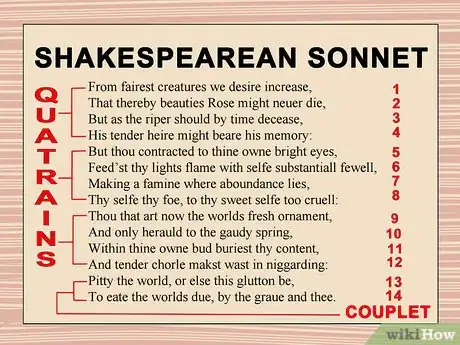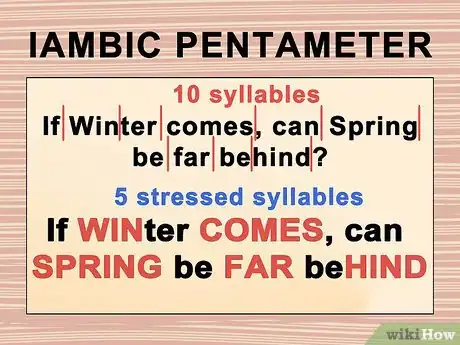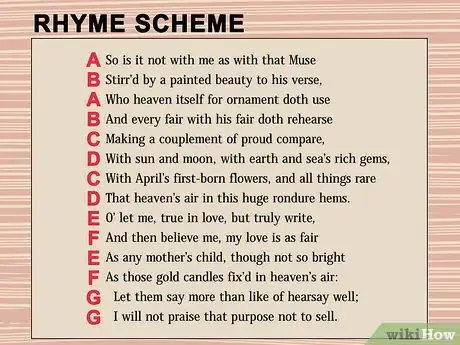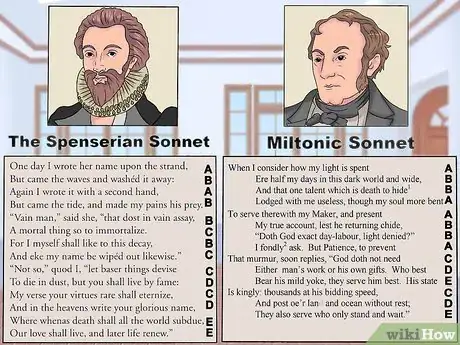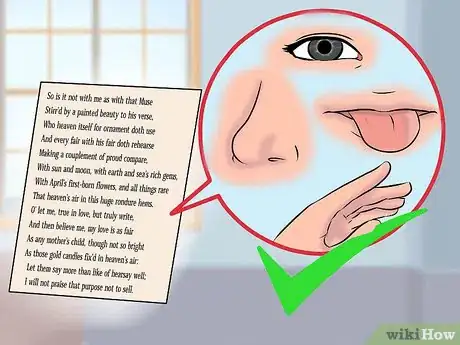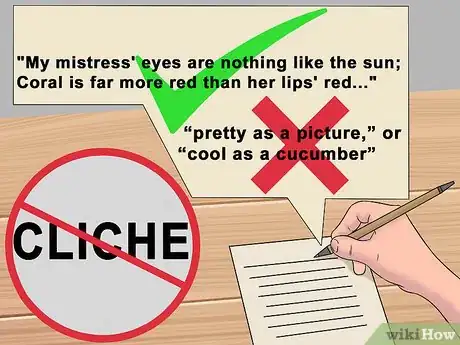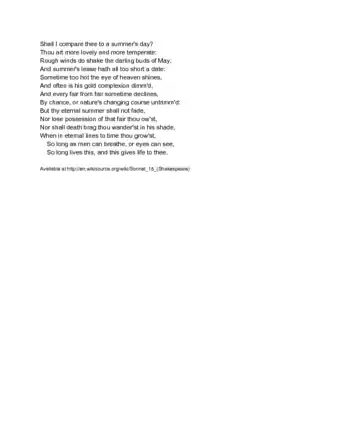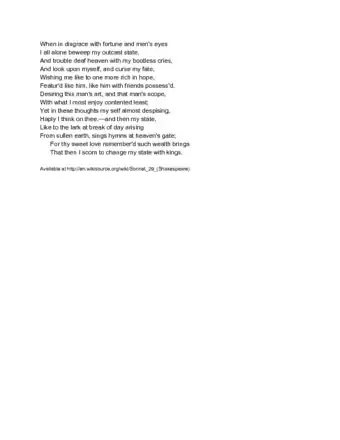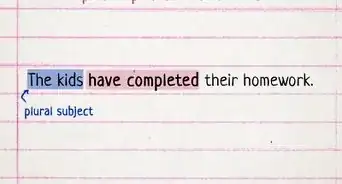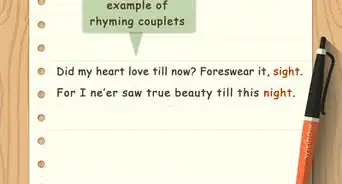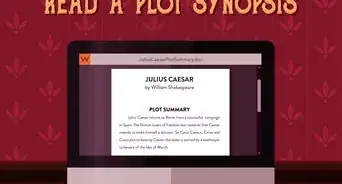This article was co-authored by Michelle Golden, PhD. Michelle Golden is an English teacher in Athens, Georgia. She received her MA in Language Arts Teacher Education in 2008 and received her PhD in English from Georgia State University in 2015.
There are 9 references cited in this article, which can be found at the bottom of the page.
This article has been viewed 257,629 times.
Sonnets are poems comprised of 14 lines. The English, or Shakespearean, sonnet is written in iambic pentameter, and has a particular pattern of rhyming words at the end of every line. The final two lines rhyme with each other, and often turn the meaning of the sonnet into something new. The traditional subject of the sonnet is love, often unrequited or ambiguous love, but sonnets can be written on any topic.
Steps
Learning the Parts of a Sonnet
-
1Include 14 lines of equal length. The sonnet is known for its length: 14 lines exactly. There are many varieties of the sonnet form, but Shakespearean sonnets are always 14 lines. The quatrain is a poetic term for 4 lines of poetry that share a common sensibility, and usually share a rhyme scheme. The couplet is a poetic term for 2 lines of rhyming verse. The 14 lines of the Shakespearean sonnet is formed by using 3 quatrains (4 lines of verse x 3 repetitions = 12 lines) and 1 couplet (2 lines) to result in the required 14 lines.
- Usually, there is a problem expressed in the first three quatrains, which is then resolved by the closing couplet.
- Each quatrain extends a thought or idea expressed in the preceding quatrain.
-
2Know about iambic pentameter. Shakespearean sonnets are typically written in lines of 10 syllables, 5 of which are “stressed” when spoken aloud. For example, this line written by poet Percy Bysshe Shelley: If Winter comes, can Spring be far behind? The five stressed syllables are Win-, comes, Spring, far, -hind.[1]
- To create more variation within the lines, it’s also possible to include 11 syllables, which would end the line on an unstressed syllable. For example, this line from Shakespeare’s Sonnet #29: “Yet in these thoughts my self almost despising,” the stresses are In, thoughts, self, -most, -pis-.
- The combination of stressed and unstressed syllables are known as a metric foot. Since penta means 5, pentameter means 5 feet.
- Iambic pentameter is the rhythm that most imitates everyday speech in the English language, so it isn't really hard to write.[2]
Advertisement -
3Consider the rhyme scheme. The Shakespearean sonnet has rather strict rules about what words should rhyme at the end of every line. This pattern of rhyming end words can be symbolized by an alphabetical letter. A series of rhyming couplets can be symbolized as AABBCC, etc.[3]
- The rhyme scheme of the Shakespearean sonnet is ABAB CDCD EFEF GG.
- By looking at the rhyme scheme, you can see that there is a predictable flow to the end rhymes of each of the 14 lines.
-
4Know different versions of the English sonnet. The Spenserian sonnet, named after the famous British poet Edmund Spenser, consists of 14 lines with the rhyme scheme ABAB BCBC CDCD EE. The quatrains are linked in this form by end line of each quatrain that continues in the first line of the following quatrain.
- The Miltonic sonnet, which is what the British poet William Wordsworth often wrote, uses the rhyme scheme ABBAABBA CDECDE. This is, in fact, a version of the Italian or Petrarchan sonnet, in which the 14 lines are created by 8 lines (2 quatrains) and 6 lines (or sestet) with a volta (or turn) in the middle. The Miltonic sonnet omits the turn in the middle.
- The Shakespearean sonnet was actually developed by the Earl of Surrey in the 16th century, but it was made famous by Shakespeare in his sonnet sequence printed in 1609.
-
5Learn what makes a lyric poem. A lyric poem is written to express personal emotions, such as love and grief. A sonnet is almost always a lyric poem, rather than a dramatic or narrative poem. If you’re considering writing a sonnet, you should think about using this form to express something you feel strongly about.[4]
- In ancient Greece, a lyric was a poem written for accompaniment with the lyre, an early stringed instrument. Currently, lyric poetry is written as an expression of individual emotion.
- The word sonnet literally means “little song.”[5]
-
6Consider popular topics for sonnets. Shakespeare’s sonnets were written mostly about love, whether happy, unhappy, or forbidden love. Later poets, most notably John Donne, wrote sonnets about religious love.[6]
- Grief is another popular topic for sonnets, as grief can be seen as an expression of lost love.
- Within the topic there is a conflict that will be developed in the first quatrains, and concluded in the final quatrain.
Starting to Write Your Sonnet
-
1Think about what you want to write about. People have written sonnets about love, passion, lost love or squandered love, unrequited love, or the grief of losing a loved one. While love, grief, or other strong emotions make compelling sonnets, there are no rules about what a sonnet should be about.[7]
- If you aren’t sure what you want the topic of your poem to be, it’s okay to start with an image that captures your attention or even a quote that you find interesting to think about.
- Because the form of a sonnet is short and intense, it makes sense to use this form for interior, self-directed topics.
- Sometimes writing a poem can help you sort through an experience that’s confused or overwhelmed you. You might find yourself writing a poem to figure out your own thoughts.
- The topics of Shakespeare's own sonnets included time, love, beauty and mortality.
-
2Decide to write about an experience. One reason to write a poem is to write about an experience that’s been important in your life. Focusing on a particular moment in your life can help you address larger, more abstract, topics.[8]
- For example, if you want to write about someone your life, you might start by writing about an experience that you shared together, such as a drive or a meal.
- This event might serve as a metaphor, something that serves to convey information that’s larger than the literal meaning itself.
- An example of a sonnet written by Shakespeare about an actual experience that was also a metaphor was in Sonnet 22, where he writes about looking into a mirror and seeing the signs of aging in his own face.[9]
-
3Be specific. Using clear and concrete language is a good way to convey strong emotional experiences. Sometimes people feel like they have to write poetry using “poetic” language, when nothing could be farther from the truth. The best sonnets are written in language that is simple and direct. [10]
- Sensory detail will help you show the reader your meaning, rather than simply telling your meaning.
- Make sure to include plenty of sensory details, such as what you can smell, feel, taste, and hear.
-
4Avoid cliches in your poem. Cliches are phrases that have been used so often in language that they no longer bring any meaningful information. For example, “pretty as a picture,” or “cool as a cucumber” are comparisons that are cliches.
- One way that Shakespeare avoided cliches was to make fun of them, such as in Sonnet 130 where he writes, "My mistress' eyes are nothing like the sun; Coral is far more red than her lips' red..."[11] Because it was a common cliche to compare a woman's body to flattering images, Shakespeare does the opposite.
- One way to determine whether or not you’re using cliches in your writing is to read your poem out loud to someone else. If your reader can predict the end of any phrase before you say it, you’re probably using a cliche.
- In order to eliminate all cliches from your poem, focus on what you really intend to say.
-
5Make sure you find time for writing. Some writers can write in coffee shops or at the kitchen table, but others require a quiet room and a desk. The most important aspect of writing a poem is to make sure you set aside time to focus on your work.[12]
- Whether you write your poetry in a journal, a notebook, or on your computer is up to you.
- There’s no “wrong way” to write your poem, so feel free to explore as many different writing styles as you’d like.
-
6Consider writing a “crown of sonnets.” If you find that you’d like to extend your sonnet past the 14-line limit, consider writing a sonnet sequence, often referred to as “a crown of sonnets.” The sonnet sequence is a collection of linked sonnets regarding the same subject matter.[13]
- Often, the last line of the sonnet doubles as the opening line of the following sonnet.
- The final sonnet’s last line may be the first line of the initial sonnet.
Sample Sonnets
Community Q&A
-
QuestionHow do I make the words rhyme?
 Community AnswerTry using an online rhyming dictionary if you're having trouble. Just search "rhyming dictionary."
Community AnswerTry using an online rhyming dictionary if you're having trouble. Just search "rhyming dictionary." -
QuestionWe are trying to figure out if our poem is correctly done. How can we tell for sure?
 Community AnswerRead it to yourself and then read it to someone else. If it sounds correct, well done. If not, try again.
Community AnswerRead it to yourself and then read it to someone else. If it sounds correct, well done. If not, try again. -
QuestionHow do I write a sonnet like Shakespeare if it is about a family member?
 LouisaCommunity AnswerShakespeare mostly focused on romantic love, but he also uses metaphors and personification, deep emotions, nature, and carefully crafted and articulate ideas to make his poems. All of these can translate into your poem.
LouisaCommunity AnswerShakespeare mostly focused on romantic love, but he also uses metaphors and personification, deep emotions, nature, and carefully crafted and articulate ideas to make his poems. All of these can translate into your poem.
References
- ↑ http://www.english.illinois.edu/maps/sonnet.htm
- ↑ http://server.riverdale.k12.or.us/~bblack/meter.html
- ↑ https://www.poets.org/poetsorg/text/poetic-form-sonnet
- ↑ http://www.english.illinois.edu/maps/sonnet.htm
- ↑ http://edhelper.com/ReadingComprehension_31_15.html
- ↑ http://www.english.illinois.edu/maps/sonnet.htm
- ↑ https://www.poets.org/poetsorg/text/poetic-form-sonnet
- ↑ http://www.writersdigest.com/editor-blogs/poetic-asides/advice/5-ways-how-to-write-a-poem
- ↑ http://www.shakespeare-online.com/sonnets/22.html
